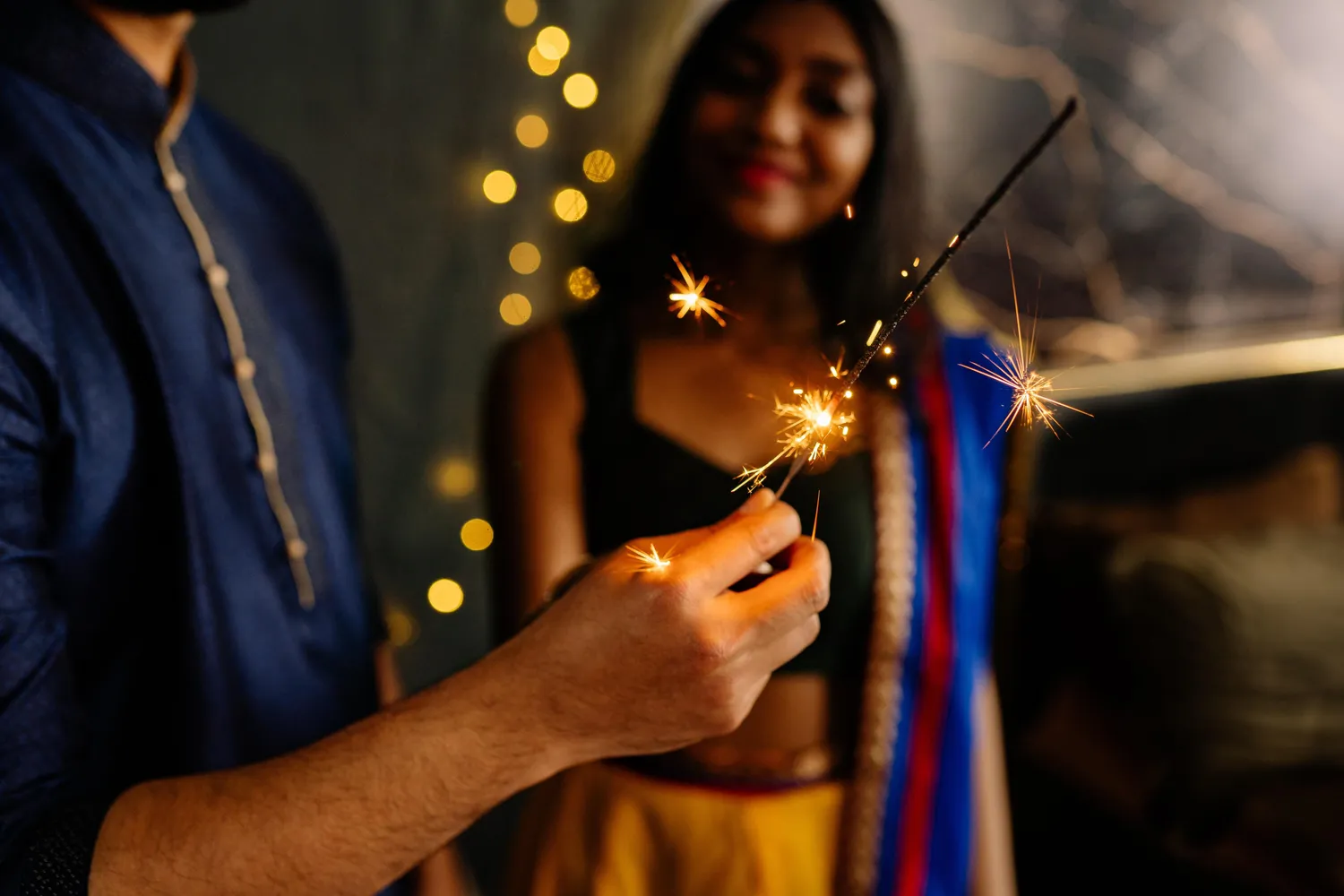The Role of Fireworks in Diwali Celebrations
Diwali, the Indian Festival of Lights, is unimaginable without fireworks. From their origins in folklore to their evolution through the centuries, firecrackers create the sights, sounds and spirit of the celebrations.
This article unpacks everything you need to know about the history, culture, safety, and spectacle of Diwali fireworks. Gain insights into different firework types, regional variations in traditions, and the industry impact.
Understand their significance beyond entertainment - the deeper meanings and symbolism that have made fireworks integral to Diwali across time, distance and diversity.

The Significance of Fireworks in Diwali
Fireworks are an iconic part of Diwali celebrations. Their dazzling lights and thundering sounds create an atmosphere of joy and community. But firecrackers also carry profound cultural and spiritual symbolism deeply woven into the fabric of the festival.
A Rich History
Fireworks, from a historical perspective, date back centuries in China. Fireworks spread along the Silk Route to India by the 14th century. Their integration into Diwali festivities has an extensive 500-year history, with deeper meaning beyond spectacle.
Fireworks represent the victory of light over darkness, good over evil. Their illumination replicates the lighting of earthen lamps to guide Lord Rama home after exile. The loud report of firecrackers heralds the triumph over demons. This symbolism remains potent today.
From paper lanterns to fireworks, light festivals around the world often share common roots. Ancient Chinese Lantern Festivals used delicate floating paper globes. Over time, booming fireworks became incorporated as a spectacular complement to the muted lanterns. In its essence, light triumphing over shadow retains universal appeal.
Scriptural Significance
Hindu scriptures link fireworks to key Diwali narratives. In the Ramayana, they celebrate Lord Rama's return after vanquishing the demon king Ravana. The fireworks symbolise the triumph of light over darkness, good over evil, and dharma over adharma.
Goddess Kali's victory over the demons Shumbha and Nishumbha is also associated with Diwali fireworks. They represent righteous power destroying malicious forces. For Hindus, fireworks replicate divine rejoicing at the restoration of justice.
Myth and symbolism across Hindu texts intertwine firecrackers with tales of gods conquering demons. The bursting lights mirror divine joy at the defeat of wickedness. Fireworks take on symbolic meaning beyond spectacle.
Cultural Spirit
Beyond religious stories, fireworks ignite cultural spirit and community. Their sights, smells, and sounds tap deeply into nostalgia and identity. The shared experience transports people to childhood joys and simpler times.
For India's diaspora worldwide, fireworks maintain cultural connection. The shared ritual binds together far-flung immigrant communities through a bittersweet mix of belonging and displacement.
The role of fireworks in celebrations across cultures is now global, but originated in specific spiritual contexts like Diwali. Their long cultural history gives fireworks layers of meaning beyond entertainment spectacle.
No matter how technology evolves, fireworks retain their power to evoke the essence of Diwali. Their symbolic resonance persists across generations, carrying forward the Festival of Lights.
Safe Diwali Celebrations
Now don't get us wrong, we love a good fireworks display. But firework safety should always come first when celebrating Diwali. A few simple precautions will help ensure the festival remains a joyous occasion for everyone involved.
Safety Measures for Fireworks
When lighting fireworks, make sure to follow some common sense safety tips:
Choose an open outdoor location with level ground and no overhanging obstacles.
Light fireworks on hard surfaces like pavements rather than dry grass or brush.
Keep water buckets or hose pipes handy in case of accidental fires.
Wear close-fitting clothes and tie back long hair. Avoid flowing dupattas near fireworks.
Designing firework displays involves carefully planning launch sites, angles, timings etc. But even smaller home fireworks need some layout thought.
Use long sticks or tubes to light fireworks from a distance. Never lean over burning fireworks.
Light one firework at a time and move away quickly after lighting.
Do not allow children to handle fireworks unsupervised. Ensure proper adult supervision at all times.
Dispose of used fireworks properly in buckets of water before discarding them.
Following basic precautions will let us enjoy fireworks fully while avoiding nasty burns or injuries.
First Aid and Emergency Procedures
In case of any accidents, stay calm but act quickly. Have emergency contact numbers handy for medical assistance. For minor burns, run cool water over the wound for 10-15 minutes. Do not apply creams, ointments or ice. Bandage lightly and get medical help if required.
For eye injuries, flush the eyes out thoroughly with clean water. Do not rub. Seek medical assistance immediately.
In case of severe injuries, call emergency services right away. Keep the victim comfortable till medical help arrives.
Legal Guidelines and Restrictions
Familiarise yourself with firework laws and be sure to follow all local firework regulations too. Purchase from licensed sellers like Chorlton Fireworks rather than illegal roadside vendors.
Use fireworks only on Diwali night and at prescribed times, like Bonfire Night or New Year’s Eve. Bursting loud firecrackers outside the regulated hours can attract fines or prosecution.
Steer clear of banned explosives – you want spectators to go "oooh" and "aaah" not "ouch!" Let's keep things safe as well as spectacular. Be sure to use fireworks safely at home if you are doing a DIY firework display.
By following some common sense guidelines, we can make sure Diwali remains an enjoyable and accident-free celebration for everyone. Safety does not mean compromising on the fun and dazzle of fireworks. It just takes some smart precautions and responsible behaviour from all of us. Happy Diwali to all!

The Environmental Impact and Alternatives
Now don't get us wrong - we love a dazzling fireworks display as much as anyone. But let's chat a bit about how we can celebrate Diwali sustainably. There are some excellent eco-friendly options that reduce the environmental impact without compromising on the festive excitement.
The Environmental Toll of Fireworks
The smoke and noise from firecrackers can cause some pollution, there's no doubt about that. But modern low-smoke and low-noise fireworks have reduced that impact. Used responsibly and in moderation, fireworks need not be detrimental to the environment.
Of course, excessive bursting of loud bangers can cause noise and air pollution. Fireworks and air quality: an environmental concern? It's about balance - spectacular but safe shows are possible with some common sense.
We think most fireworks lovers are happy to make small changes that protect our surroundings.
Eco-Friendly Alternatives
For those looking to totally avoid firecracker pollution, there are some wonderful eco-friendly alternatives to light up Diwali night:
Biodegradable seed crackers - These plantable fireworks contain seeds that sprout into plants and flowers after use!
Eco-Sparklers - look and perform just like a traditional iron sparkler but they are made of wood. Perfect for any celebration, these new ECO Sparkler Sticks are kinder to the environment and 100% biodegradable
Laser light shows - State-of-the-art laser projectors can create dazzling displays in the night sky!
Candle and lamp decorations - Traditional earthen lamps radiate a peaceful glow throughout Diwali.
Rangoli artworks - Vibrant rangoli patterns made from natural materials embody the festival's essence.
Sky lanterns - Airborne paper lanterns make for a stunning and eco-friendly spectacle.
With some creativity, we can dazzle the night while caring for the environment.
Community Initiatives for a Green Diwali
Many community organisations work to raise awareness on celebrating an eco-friendly Diwali:
Clean-up drives to clear firework debris from streets and beaches.
Campaigns on social media and in schools/colleges spreading green messages.
Competitions for best eco-friendly decorations and firework alternatives.
Drives for donating old clothes/toys and planting trees as Diwali charity.
Small personal steps combined with community action can make Diwali greener. The festival's message of good conquering evil applies just as much to environmental protection nowadays!
The History and Evolution of Fireworks in Diwali
Fireworks have been part of Diwali celebrations for centuries, but the traditions have evolved over time. Let's have a look at the fascinating history of firecrackers and how celebrations have changed.
The Origins of Firework Use in Diwali
Fireworks originated in China and slowly spread westward along the Silk Route. They likely reached India by the 1400s and were quickly incorporated into Diwali festivities.
The bursting of firecrackers tied into the story of Lord Rama's return from exile, which Diwali commemorates. The people of Ayodhya welcomed him back with thousands of earthen lamps and fireworks. So the origins link back to the religious tales behind the festival.
Fireworks: A Historical Perspective shows that they were soon integral to Diwali's rituals across India.
Evolution Over the Centuries
In earlier eras, fireworks were more muted affairs with simpler crackers and sparklers. Handmade paper-cased firecrackers would be set off near temples and homes.
Over centuries, the fireworks became louder, more widespread and elaborate. Firecracker varieties diversified into aerial shells, fountains and more. Celebrations evolved into brilliant public displays in cities and communities.
But the core tradition always remained - fireworks as part of the spiritual celebration of Lord Rama's return and the victory of light over darkness.
Modern-Day Firework Celebrations
Today, fireworks for Diwali are at their most spectacular. Advances in pyrotechnics allow for dazzling displays synchronised to music. While staying rooted in tradition, celebrations have become grander and competitive.
Public firework shows aim to outdo each other in size, duration and special effects. Even families try putting on the biggest display in the neighbourhood.
But community spirit persists alongside the friendly rivalry. Firework festivals and competitions around the globe retain a sense of communal festivity.
The sights and sounds of firecrackers unite people in a shared experience. While the methods evolved, fireworks remain integral to Diwali. The simple roots of the tradition endure alongside modern innovations. Fireworks big and small continue kindling the light of the Festival of Lights.

Types of Fireworks Used in Diwali
The fireworks that light up Diwali night come in a dazzling variety of types and forms. Some classic firecrackers hold deep symbolic meaning and cultural history for the Festival of Lights. Firework experts have rated the top 10 Diwali fireworks so let's explore popular firework varieties, regional differences, and the rich traditions behind them.
Popular Types of Fireworks
Classic fireworks that feature prominently in Diwali include:
Sparklers - Handheld sticks that fizzle with miniature light showers. A safe favourite for children.
Fountains - Ground fireworks that emit dramatic fizzing sparks and crackling effects. They represent divine blessings raining upon devotees.
Rockets - Fireworks that zoom into the sky and explode with colourful bursts. Symbolise prayers rising to the gods.
Smoke grenades and firecrackers - Loud explosive fireworks that create booming sounds. Replicate cannon fire from Lord Rama's return celebrations.
Catherine wheels - Fireworks that emit sparks while spinning on the ground. Named for their shape, they signify divine flowers blooming after evil's destruction.
Indoor/novelty fireworks - Non-explosive fireworks like sparklers and ground spinners. Represent the victory of light over darkness, a key Diwali theme.
From loud aerial rockets to serene sparklers, firecrackers of all types kindle the atmosphere on Diwali night.
Symbolism and History Behind Fireworks
Fireworks hold cultural and spiritual symbolism tied to the myths and legends behind Diwali:
Illuminating the skies with sparkling lights represents the triumph of good over evil, and knowledge over ignorance.
The loud sounds are meant to herald Lord Rama's return after vanquishing the demon Ravana in Lanka.
Bursting crackers are thought to drive away inauspicious forces and evoke blessings for prosperity.
The rich colours mirror the vibrant rangoli decorations welcoming Lakshmi, goddess of wealth and prosperity.
Fireworks and folklore: myth and symbolism have been closely linked in India for centuries. The sights and sounds transport people into Diwali's traditional roots.
Regional Variations in Firework Types
While major types like sparklers and rockets are ubiquitous, some regions have their unique firework varieties that add local flair:
North India loves Colourful high-decibel atom bombs that create deafening sounds and ground-shaking effects.
Goa has noisy bronca shells and torpedo rockets reflecting its Portuguese cultural influences.
Tamil Nadu favours amittu, spinning ground spinners that create spectacular circular light patterns.
Karnataka and Andhra Pradesh enjoy chakkars, fountains that rotate speedily while emitting sparks.
The diverse regional firework types add local flavour to the celebrations while retaining familiar favourites. The varieties light up the skies in amazing patterns, colours and displays that are unique to each area.
From symbolic rockets to noisy crackers, fireworks form an integral part of Diwali. Their sights, sounds and history transport everyone into the essence of the Festival of Lights.
Fireworks Across Different Cultures
While fireworks unite Diwali celebrations everywhere, cultural nuances make each region's festivities unique. From boisterous competitive displays to simple spiritual rituals, let's dive deeper into the cultural variations.
North vs. South India
In North India, Diwali tends to be celebrated more loudly and extravagantly. Professional firework shows compete to be bigger, longer and more spectacular than rivals with elaborate aerial rockets and deafening bombs. Even families try to outdo each other in their neighbourhoods, sometimes getting competitive instead of festive!
In contrast, South Indian celebrations are often more low-key and spiritual. Simple fountains and sparklers are preferred to focus on the religious significance, rather than ostentatious noise-making competitions. Temple firework displays retain a traditional flavour rather than modern innovations. For instance, in Mysore, the entire city lights up with thousands of simple oil lamps.
The role of fireworks in celebrations across cultures can highlight deeper contrasts between the loud North and quiet South. But the essence of victory of light over darkness remains intact.
Diwali in Other Religions
Diwali is celebrated across religions, though firework traditions vary:
Sikhs mark Bandi Chhor Diwas so fireworks symbolise freedom and justice. More noise to announce the release of Guru Hargobind from prison.
Jains commemorate Lord Mahavira's attainment of moksha. Celebrations tend to avoid loud firecrackers and focus on prayer and meditation instead.
Buddhists mark Emperor Ashoka's conversion to Buddhism and non-violence. Often fireworks are avoided, candles and lanterns are preferred.
The subtle distinctions showcase how the role of fireworks adapts to fit each faith's history and principles.
Unique Regional Traditions
Adding local flair, some regions incorporate unique fireworks:
In Goa, old Portuguese influence leads to noisy bombs and torpedoes reminiscent of cannon fireworks.
In West Bengal, Kali Puja fireworks honour the goddess' victory over evil forces with dramatic flair.
In Varanasi, the iconic ghats host displays by the sacred Ganges for a spectacle visible across the shimmering river.
In Mathura and Vrindavan, celebrations glorify Lord Krishna's role in Diwali through youthful fireworks befitting his playful persona.
The diverse regional variations allow locals to integrate their distinct cultures while retaining the broader spirit of Lord Rama's return. Creative and boisterous, quiet and spiritual, fireworks bridge subcultures across Diwali.
Fireworks and the Economy
The fireworks industry certainly sparks up around Diwali! From livelihoods to revenues, let's chat about the economic impact of firecrackers.
Economic Impact on the Fireworks Industry
Diwali accounts for over 80% of India's annual fireworks sales, averaging ₹6000 crores! The firecracker market flourishes around the Festival of Lights. Manufacturers, distributors, and sellers see a massive surge in demand and profits.
The lights and sounds of Diwali fireworks support hundreds of thousands of livelihoods from production to retail. It is a make-or-break time of year for the industry. No other holiday compares to boosting firework sales and revenues.
Job Creation and Employment
The firecracker industry employs lakhs of workers across India. While many are involved year-round, even more seasonal jobs open up leading up to Diwali.
Extra hands are needed in factories for production. Temporary retail shops crop up to sell fireworks to the excited masses. Transport, inventory, and logistics also need staffing ramp-ups to handle the peak.
The surge in activity benefits workers seeking temporary Diwali employment across multiple sectors.
Local vs. Imported Fireworks
While locally made firecrackers dominate sales, Chinese imports have grown over 30% in recent years. Dazzling aerial fireworks are often sourced from China for their quality and competitive pricing.
However, made-in-India fireworks still account for over 90% of Diwali sales. The cottage industry employs far more people than imported stock.
With support, India's firework makers can raise quality while retaining the essence of indigenous production.
The sights and sounds of Diwali directly light up the prospects of India's fireworks industry and workforce. With fair practices, that illuminate livelihoods and prosperity across the country.
350 Barlow Moor Rd
Chorlton
Manchester, M21 8AZ
07810 222123
info@chorltonfireworks.com

















































